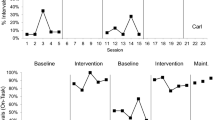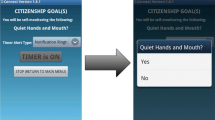Abstract
Objectives
Increasing numbers of transition-age youth with autism spectrum disorder (ASD) are pursuing postsecondary education and may benefit from interventions to support them in the college environment. The purpose of this study was to examine the efficacy of a self-monitoring application (app) to increase on-task classroom behavior of a postsecondary student with ASD.
Methods
An alternating treatment design with a baseline and best treatment condition was utilized to examine the efficacy of a technology-based self-monitoring app, I-Connect. One 19-year-old male postsecondary student with ASD used the I-Connect app in a large, lecture-style introductory-level course at a public university. Self-monitoring prompts were delivered via a handheld tablet, and on-task behavior was measured using momentary time sampling.
Results
The participant demonstrated an increase in on-task behavior when using the I-Connect app. However, a functional relation between the use of the app and on-task behavior cannot be concluded due to limitations in the research design.
Conclusions
Implications and suggestions for future research related to supporting postsecondary students with ASD using technology-based self-monitoring interventions are discussed.


Similar content being viewed by others
References
ASD On The Go: Modules (2019). Retrieved from https://asdonthego.ku.edu/. Accessed 1 May 2019.
Barlow, D. H., Nock, M. K., & Hersen, M. (2009). Single case experimental design: strategies for studying behavior change. London: Pearson.
Barnhill, G. P. (2016). Supporting students with Asperger syndrome on college campuses: current practices. Focus on Autism and Other Developmental Disabilities, 31(1), 3–15. https://doi.org/10.1177/1088357614523121.
Barton, E. E., Lloyd, B. P., Spriggs, A. D., & Gast, D. L. (2018). Visual analysis of graphic data. In J. R. Ledford & D. L. Gast (Eds.), Single case research methodology: applications in special education and behavioral sciences (3rd ed., pp. 179–215). New York: Routledge.
Beckman, A., Mason, B., Wills, H. P., Garrison-Kane, L., & Huffman, J. M. (2019). Improving behavioral and academic outcomes for students with autism spectrum disorder: testing an app-based self-monitoring intervention. Education and Treatment of Children, 42(2), 225–244. https://doi.org/10.1353/etc.2019.0011.
Bouck, E., Savage, M., Meyer, N., Taber-Doughty, T., & Hunley, M. (2014). High-tech or low tech? Comparing self-monitoring systems to increase task independence for students with autism. Focus on Autism and Other Developmental Disorders, 29(3), 156–167. https://doi.org/10.1177/1088357614528797.
Bruhn, A., & Wills, H. P. (2018). Emerging research and development in technology-based self-monitoring. In T. Landrum, B. G. Cook, & M. Tankersley (Eds.), Advances in learning and behavioral disabilities (pp. 51–68). Bingley: Emerald Publishing Limited.
Bruhn, A., Mcdaniel, S., & Kreigh, C. (2015). Self-monitoring interventions for students with behavior problems: a systematic review of current research. Behavioral Disorders, 40(2), 102–121. https://doi.org/10.17988/bd-13-45.1.
Bruhn, A. L., Waller, L., & Hasselbring, T. S. (2016). Tweets, texts, and tablets: the emergence of technology-based self-monitoring. Interventions in School and Clinic, 51(30), 157–162. https://doi.org/10.1177/1053451215585803.
Cai, R. Y., & Richdale, A. L. (2016). Educational experiences and needs of higher education students with autism spectrum disorder. Journal of Autism and Developmental Disorders, 46, 31–41. https://doi.org/10.1007/s10803-015-2535-1.
Clemons, L. L., Mason, B. A., Garrison-Kane, L. G., & Wills, H. P. (2016). Self-monitoring for high school students with disabilities: a cross-categorical investigation of I-Connect. Journal of Positive Behavior Interventions, 18(3), 145–155. https://doi.org/10.1177/1098300715596134.
College Autism Spectrum: College Programs. (2019). Retrieved from http://collegeautismspectrum.com/collegeprograms/. Accessed 1 May 2019.
Constantino, J. N. (2012). Social Responsiveness Scale-2: adult self-report (SRS-2). Torrance: Western Psychological Services.
Cooper, J. O., Heron, T. E., & Heward, W. L. (2007). Applied behavior analysis. Upper Saddle River: Prentice-Hall, Inc..
Coyne, M. D., Cook, B. G., & Therrien, W. J. (2016). Recommendations for replication research in special education. Remedial and Special Education, 37(4), 244–253. https://doi.org/10.1177/0741932516648463.
Crutchfield, S. A., Mason, R. A., Chambers, A., Wills, H. P., & Mason, B. A. (2015). Use of a self-monitoring application to reduce stereotypic behavior in adolescents with autism: a preliminary investigation of I-Connect. Journal of Autism and Developmental Disorders, 45(5), 1146–1155. https://doi.org/10.1007/s10803-014-2272-x.
Edyburn, D. (2013). Critical issues in advancing the special education technology evidence base. Exceptional Children, 80, 7–24. https://doi.org/10.1177/001440291308000107.
Elias, R., & White, S. (2018). Autism goes to college: understanding the needs of a student population on the rise. Journal of Autism and Developmental Disorders, 48(3), 732–746. https://doi.org/10.1007/s10803-017-3075-7.
Finn, L., Ramasamy, R., Dukes, C., & Scott, J. (2015). Using WatchMinder to increase the on task behavior of students with autism spectrum disorder. Journal of Autism and Developmental Disorders, 45(5), 1408–1418. https://doi.org/10.1007/s10803-014-2300-x.
Holifield, C., Goodman, J., Hazelkorn, M., & Heflin, J. (2010). Using self-monitoring to increase attending to task and academic accuracy in children with autism. Focus on Autism and Other Developmental Disabilities, 25(4), 230–238. https://doi.org/10.1177/1088357610380137.
Jackson, S., Hart, L., Brown, J. T., & Volkmar, F. (2018). Brief report: self-reported academic, social, and mental health experiences of post-secondary students with autism spectrum disorder. Journal of Developmental Disorders, 48, 643–650. https://doi.org/10.1007/s10803-017-3315-x.
Kratochwill, T. R., Hitchcock, J. H., Horner, R. H., Levin, J. R., Odom, S. L., Rindskopf, D. M., & Shadish, W. R. (2013). Single-case intervention research design standards. Remedial and Special Education, 34(1), 26–38. https://doi.org/10.1177/0741932512452794.
Lipscomb, S., Haimson, J., Liu, A.Y., Burghardt, J., Johnson, D.R., & Thurlow, M.L. (2017). Preparing for life after high school: the characteristics and experiences of youth in special education. Findings from the National Longitudinal Transition Study 2012. In Volume 2: Comparisons across disability groups: Full report (NCEE 2017-4018). Washington, DC: U.S. Department of Education, Institute of Education Sciences, National Center for Education Evaluation and Regional Assistance.
McKeon, B., Alpern, C., & Zager, D. (2013). Promoting academic engagement for college students with autism spectrum disorder. Journal of Postsecondary Education and Disability, 26(4), 353–366.
Morningstar, M. E., Lombardi, A., Fowler, C. H., & Test, D. W. (2017). A college and career readiness framework for secondary students with disabilities. Career Development and Transition for Exceptional Individuals, 40(2), 79–91. https://doi.org/10.1177/2165143415589926.
Newman, L., Wagner, M., Knokey, A.-M., Marder, C., Nagle, K., Shaver, D., & Wei, X. (2011). The post-high school outcomes of young adults with disabilities up to 8 years after high school. A Report from the National Longitudinal Transition Study-2 (NLTS2) (NCSER 2011-3005). Menlo Park: SRI International. https://doi.org/10.1037/e601272011-001.
Robbins, S. T., Allen, J., Casillas, A., & Peterson, C. H. (2006). Unraveling the differential effects of motivational and skills, social, and self-management measures from traditional predictors of college outcomes. Journal of Educational Psychology, 98(3), 598–616. https://doi.org/10.1037/0022-0663.98.3.598.
Rosenbloom, R. K., Mason, R. A., Wills, H. P., & Mason, B. A. (2016). Technology delivered self-monitoring application to promote successful inclusion of an elementary student with autism. Assistive Technology, 28(1), 9–16. https://doi.org/10.1080/10400435.2015.1059384.
Roth, R. M., Isquith, P. K., & Gioia, G. A. (2005). Behavior Rating Inventory of Executive Function-adult version. Lutz, FL: Psychological Assessment Resources, Inc..
Roux, A. M., Rast, J. E., Anderson, K. A., & Shattuck, P. T. (2017). National autism indicators report: developmental disability services and outcomes in adulthood. Philadelphia: Life Course Outcomes Program, A.J. Drexel Autism Institute, Drexel University.
Schardt, A., Miller, F., & Bedesem, P. (2018). The effects of CellF-monitoring on students’ academic engagement: a technology-based self-monitoring intervention. Journal of Positive Behavior Interventions, 21(1), 42–49. https://doi.org/10.1177/1098300718773462.
Sidman, M. (1960). Tactics of scientific research: evaluating experimental data in psychology. New York: Basic Books, Inc..
Volkmar, F. R., Jackson, S. L. J., & Hart, L. (2017). Transition issues and challenges for youth with autism spectrum disorders. Pediatric Annals, 46(6), e219–e223. https://doi.org/10.3928/19382359-20170519-03.
White, S. W., Elias, R., Salinas, C. E., Capriola, N., Conner, C. M., Asselin, S. B., et al. (2016). Students with autism spectrum disorder in college: results from a preliminary mixed method needs analysis. Research in Developmental Disabilities, 56, 29–40. https://doi.org/10.1016/j.ridd.2016.05.010.
Wills, H. P., & Mason, B. A. (2014). Implementation of a self-monitoring application to improve on-task behavior: a high school pilot study. Journal of Behavioral Education, 23, 421–434. https://doi.org/10.1007/s10864-014-9204-x.
Wolery, M., Gast, D. L., & Ledford, J. R. (2018). Comparative designs. In J. R. Ledford & D. L. Gast (Eds.), Single case research methodology: applications in special education and behavioral sciences (3rd ed., pp. 283–335). New York: Routledge.
Xo, S., Wang, J., & Lee, G. (2016). Using self-monitoring with guided goal setting to increase academic engagement for a student with autism in an inclusive classroom in China. The Journal of Special Education, 51(2), 106–114. https://doi.org/10.1177/0022466916679980.
Author information
Authors and Affiliations
Contributions
JMH: established university partnership, conducted recruitment, designed the study, implemented training, collected data, and collaborated in the writing and editing of the manuscript. LAB: collected data and collaborated in the writing and editing of the manuscript. EKW: collected data and collaborated in the writing and editing of the manuscript. HPW: participated in the design of the study and revised the final manuscript for important intellectual content. RAM: participated in the design of the study and revised the final manuscript for important intellectual content.
Corresponding author
Ethics declarations
Conflict of Interest
The authors declare that they have no conflict of interest.
Ethics Statement
The study was approved by the University of Kansas institutional review board prior to recruitment and data collection.
Informed Consent Statement
Informed consent was obtained from legal guardians and assent was obtained from study participants prior to data collection.
Additional information
Publisher’s Note
Springer Nature remains neutral with regard to jurisdictional claims in published maps and institutional affiliations.
Rights and permissions
About this article
Cite this article
Huffman, J.M., Bross, L.A., Watson, E.K. et al. Preliminary Investigation of a Self-monitoring Application for a Postsecondary Student with Autism. Adv Neurodev Disord 3, 423–433 (2019). https://doi.org/10.1007/s41252-019-00124-y
Published:
Issue Date:
DOI: https://doi.org/10.1007/s41252-019-00124-y




